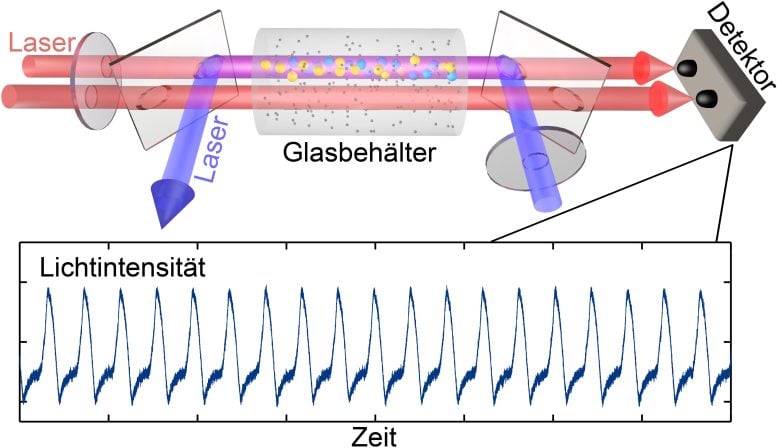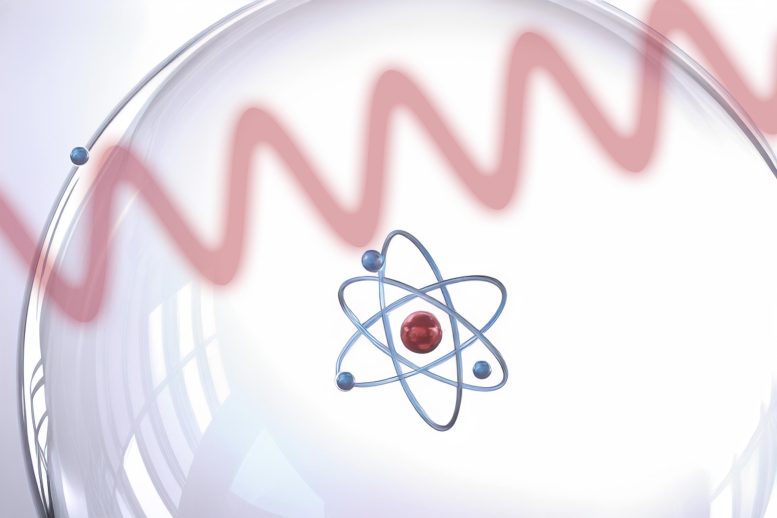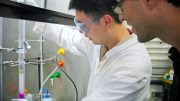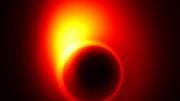Researchers have created an extremely exotic state of matter. Its atoms have a diameter a hundred times larger than usual.
Time crystals, originally proposed by Nobel laureate Frank Wilczek in 2012, have now been successfully created using Rydberg atoms and laser light at Tsinghua University in China, with theoretical support from TU Wien in Austria. This new state of matter does not repeat in space like traditional crystals, but in time, displaying spontaneous periodic rhythms without an external stimulus, a phenomenon known as spontaneous symmetry breaking.
A crystal is an arrangement of atoms that repeats itself in space, in regular intervals: At every point, the crystal looks exactly the same. In 2012, Nobel Prize winner Frank Wilczek raised the question: Could there also be a time crystal – an object that repeats itself not in space but in time? And could it be possible that a periodic rhythm emerges, even though no specific rhythm is imposed on the system and the interaction between the particles is completely independent of time?
For years, Frank Wilczek’s idea has caused much controversy. Some considered time crystals to be impossible in principle, while others tried to find loopholes and realize time crystals under certain special conditions. Now, a particularly spectacular kind of time crystal has successfully been created at Tsinghua University in China, with the support from TU Wien in Austria. The team used laser light and very special types of atoms, namely Rydberg atoms, with a diameter that is several hundred times larger than normal. The results have now been published in the journal Nature Physics.
Spontaneous Symmetry Breaking
The ticking of a clock is also an example of a temporally periodic movement. However, it does not happen by itself: Someone must have wound the clock and started it at a certain time. This starting time then determined the timing of the ticks. It is different with a time crystal: according to Wilczek’s idea, a periodicity should arise spontaneously, although there is actually no physical difference between different points in time.
“The tick frequency is predetermined by the physical properties of the system, but the times at which the tick occurs are completely random; this is known as spontaneous symmetry breaking,” explains Prof Thomas Pohl from the Institute of Theoretical Physics at TU Wien.

A static system with a continuous input of light leads to time-dependent periodic signals. Credit: TU Wien
Thomas Pohl was in charge of the theoretical part of the research work that has now led to the discovery of a time crystal at Tsinghua University in China: Laser light was shone into a glass container filled with a gas of rubidium atoms. The strength of the light signal that arrived at the other end of the container was measured.
“This is actually a static experiment in which no specific rhythm is imposed on the system,” says Thomas Pohl. “The interactions between light and atoms are always the same, the laser beam has a constant intensity. But surprisingly, it turned out that the intensity that arrives at the other end of the glass cell begins to oscillate in highly regular patterns.”
Giant Atoms
The key to the experiment was to prepare the atoms in a special way: The electrons of an atom can orbit the nucleus on different paths, depending on how much energy they have. If energy is added to the outermost electron of an atom, its distance from the atomic nucleus can become very large. In extreme cases, it can be several hundred times further away from the nucleus than usual. In this way, atoms with a giant electron shell are created – so-called Rydberg atoms.
“If the atoms in our glass container are prepared in such Rydberg states and their diameter becomes huge, then the forces between these atoms also become very large,” explains Thomas Pohl. “And that in turn changes the way they interact with the laser. If you choose laser light in such a way that it can excite two different Rydberg states in each atom at the same time, then a feedback loop is generated that causes spontaneous oscillations between the two atomic states. This in turn also leads to oscillating light absorption.” All by themselves, the giant atoms stumble into a regular beat, and this beat is translated into the rhythm of the light intensity that arrives at the end of the glass container.
“We have created a new system here that provides a powerful platform for deepening our understanding of the time crystal phenomenon in a way that comes very close to Frank Wilczek’s original idea,” says Thomas Pohl. “Precise, self-sustained oscillations could be used for sensors, for example. Giant atoms with Rydberg states have already been successfully used for such techniques in other contexts.”
Reference: “Dissipative time crystal in a strongly interacting Rydberg gas” by Xiaoling Wu, Zhuqing Wang, Fan Yang, Ruochen Gao, Chao Liang, Meng Khoon Tey, Xiangliang Li, Thomas Pohl and Li You, 2 July 2024, Nature Physics.
DOI: 10.1038/s41567-024-02542-9










Time crystals, originally proposed by Nobel laureate Frank Wilczek in 2012, have now been successfully created using Rydberg atoms and laser light at Tsinghua University in China, with theoretical support from TU Wien in Austria. This new state of matter does not repeat in space like traditional crystals, but in time, displaying spontaneous periodic rhythms without an external stimulus, a phenomenon known as spontaneous symmetry breaking.
Please ask researchers to think deeply:
1. Do you really understand time?
2. Is time and space related?
3. Is symmetry breaking the same as symmetry readjusting?
4. Is the spin of topological vortices symmetric?
5. Is topological vortices real?
6. Can the spin of topological vortices be used for timing?
7. Can topological vortices form time crystals via self-organization?
8. Can topological vortices be time crystals?
and so on.
Please witness the exemplary collaboration between theoretical physicists and experimentalists (https://zhuanlan.zhihu.com/p/701032654).
I hope researchers are not misled by the erroneous theories in the Physical Review Letters (PRL).If you are really interested in time and space, you can browse https://zhuanlan.zhihu.com/p/695926158.
Scientific research guided by correct theories can help humanity avoid detours, failures, and pretension.
Honestly I can no longer tell if you’re happy about this research or believe it at all. Also, there’s several ways you can contact Tsinghua University’s Department of Physics branch listed on their website, you can ask those questions yourself, if you actually want answers that is. You’re welcome!
PS: the article described in this post was published in the journal Nature, not Physical Review Letters (PRL). Also, as far as I’m aware, Zhihu isn’t a reputable scientific journal.
Very good!
Science and pseudoscience are not determined by a publication (such as the journal Nature, Physical Review Letters, et al.), an organization (such as Tsinghua University, American Physical Society, et al.) or a person, nor by you or me, but by mathematics the final say. Physical models must be based on mathematics or mathematical models in order to be scientific, convincing, and in accordance with natural laws.
The reason why humans are great is because they are good at thinking. The Physical Review Letters firmly believes that two sets of high-dimensional spacetime objects (such as two sets of cobalt-60) can rotate in reverse and form two objects that mirror each other. Is it a reputable scientific journal?
At least, Zhihu did not extinguish his conscience, did not harm science and society in the name of science, and did not deceive the public in the name of science.
If you are truly interested in science and physics, you can browse https://zhuanlan.zhihu.com/p/595280873 and https://zhuanlan.zhihu.com/p/643404671.
? You can’t say there is no external influence because,in this case you need a laser beam to create spontaneous periodic rythmes? And you are creating a gaseous form of Rydberg atoms? Is the gas stable?
I guess to play around with this time stuff is fun but this all has no real purpose other than a probability to note.
I see u see me

Here’s the life expectancy data in a more readable format:
### Life Expectancy at Birth (in years)
| Country | Year | Men | Women |
|—————-|——|——|——-|
| **United States** | 2023 | 68.0 | 72.0 |
| | 2040 | 67.0 | 71.0 |
| **Japan** | 2023 | 81.0 | 87.0 |
| | 2040 | 83.0 | 89.0 |
| **China** | 2023 | 72.0 | 78.0 |
| | 2040 | 75.0 | 81.0 |
| **Brazil** | 2023 | 69.0 | 76.0 |
| | 2040 | 70.0 | 78.0 |
| **South Africa** | 2023 | 60.0 | 67.0 |
| | 2040 | 62.0 | 69.0 |
### Key Observations:
1. **United States**:
– Slight decrease in life expectancy by 2040 for both men and women.
2. **Japan**:
– Expected increase in life expectancy for both men and women by 2040, maintaining its position as one of the highest life expectancies globally.
3. **China**:
– Noticeable increase in life expectancy by 2040, reflecting improvements in healthcare and living conditions.
4. **Brazil**:
– Moderate increase in life expectancy for both men and women by 2040.
5. **South Africa**:
– Expected increase in life expectancy by 2040, although it remains lower compared to other countries.
These projections illustrate varying trends in life expectancy across different countries, with notable improvements expected in Japan and China.
Should do a study on why it is that Putin created shelters for every citizen in case a catastrophic event should accur . And why our government collects not sure but maybe 3 times the revenue from taxes and they choose to only save themselves. We are on our own. Most will not survive . But Russians will. The government takes takes ( takes)
40 percent of our earnings .The amount we are paid for our labor almost half of that number is taken from us rite off the top before we even jump in our taxes vehicle driving on our taxed fuel. On roads that we built ( when have you seen a congress person with a shovel or driving a steam roller) so ya roads that we built, so we can get home to our home where we pay property tax .finally get to sit in our lazy boy that we paid tax on top of the purchase price. Why our partner cooks taxed food using inflated overly priced energy and so we eat our taxed dinner . Watching propaganda ( which ever version of the truth they feel like disclosing) on tv oh taxed tv set and taxed service. Go to our taxed bed lay out head on our taxed pillow they haven’t taxed snuggling with our partner yet……
Wake up sit on your taxed toilet wipe with your taxed tissue and do it again.
So that they can be sure to have protection in case their foreign policies backfire and they actually piss someone off.
Hmmm which part of this is for the people.
Every tax Dollar can and will be used against you.
This is my observation of living in America.